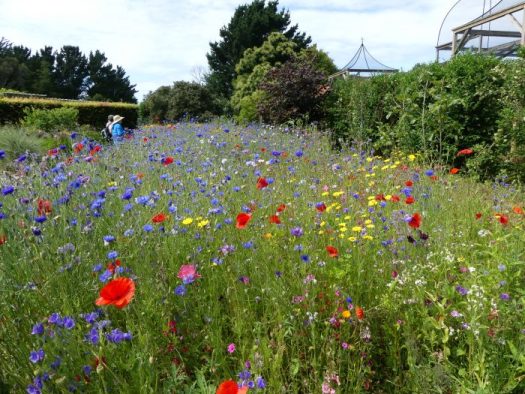As a landscape designer, a frequent request from clients is getting rid of their lawn and replacing with more natural alternatives. Water hogging and pesticide laden lawns are being replaced nowadays with different varieties of grasses, meadows, and other perennials that form a low growing mat, like thyme or mazus.

Ubiquitous American Lawns
Today lawns cover more than 63,000 square miles- almost the size of Texas! And Americans are still in love with their lawns, but this is gradually changing. Turfgrass is mostly made up of non-native grass species and requires a huge amount of water, pesticides, fertilizer, labor, and fuel. There are definitely areas where lawns are useful, like in playing fields, but lawns are way over-planted. The bio-diversity of a lawn is extremely low compared to meadows and other garden plantings, and cost billions of dollars each year to maintain, as well as contribute to water pollution. More and more botanic gardens such as Longwood Gardens and the new Delaware Botanic Gardens are establishing flourishing beautiful expanses of meadow to showcase the beauty of natives in a natural setting.


The decline of our native pollinators has been traced to more lawn installation, roundup spraying, big agriculture, and less wild plantings with “weeds”.

Thyme Lawn
For one client, I removed an area of 500 square feet of turf by tilling and raking out, then planting with 1100 thyme plugs (tiny plants). Irrigated with a drip hose until the plants take root, thyme can form a thick mat of creeping foliage that blooms a sea of pink flowers in the spring. Thyme is not native to North America, but works quite well here in the right conditions. There are hundreds of varieties of thyme, but I stick with the low creeping ones.



Mazus reptans is another creeping plant that does well in partial shade to shade that spreads quickly to form a mass of creeping foliage with white or purple flowers in the spring.


Change in Attitudes
More and more, I am seeing lawns disappearing and being replaced with perennial grass alternatives like Carex or Sedges and even more radical with meadow plants, like goldenrods and other native wildflowers.



The UK is way ahead of us and establishes meadows everywhere they can, like graveyards.I have seen graveyards in England being replaced with meadow grasses instead of the buzz cuts around gravestones that you would normally see.

But how to get rid of lawns? I suggest gradually turn your property into alternative plantings. Don’t expect it to be done overnight and be cognizant of your neighbors and Home Owners Associations (HOA). Get permission and if that is not forthcoming, then try to educate others about the alternatives. I am a beekeeper and wanted to make a meadow around my beehives to increase bee foraging opportunities, and created a meadow around my beehives.

To see how I created a meadow and other strategies in creating bee habitat, go to Plant These For the Bees.
Carex and Sedges
One alternative to consider are Carex’s or Sedges to replace turfgrass. Carex pennsylvanica, commonly called Pensylvania Sedge, is a shade-loving perennial sedge that is native to dry woodland in Eastern North America. Semi-evergreen in cold winter areas, this makes a great lawn substitute for dry shady areas, where you might have had trouble growing regular turfgrass. Never needing to be mown, it grows about a foot high, spreading by rhizomes to cover large areas.

Thyme Lawn for Sunny Areas
Creeping or spreading thymes are an alternative in a sunny location with good drainage. Remove your grass by either spraying with an herbicide, tilling it under, or killing with black plastic.

Meadows
What makes a meadow? An open habitat or field covered by vegetation, usually grasses and other non-woody plants providing areas for nesting, food gathering, pollinating insects, and shelter for small animals. Many people wish to replace their lawn with a meadow but think by sprinkling seeds out of a can they can get that look.




It is important to first remove the existing turfgrass by tilling or killing it with black plastic, cardboard, or newspaper covered with mulch or soil. You can then plant with selected native and non-native plants that do well in your location to form a dense covering of perennials that will crowd out weeds.

Try using at least 80-85% native plants in your mix. Alternatively, you can use a good wildflower mix and spread the seeds after preparing your ground by raking it out, sprinkling, and raking the seeds into the soil. Firm the soil with a tool to make sure you have good contact and keep moist until the seeds sprout and get established. Don’t think you can sprinkle seeds from a can directly onto the ground and expect the meadow to appear that is pictured on the wildflower canister! There is work involved in establishing a meadow that looks picture perfect.

Maintenance is still required to weed out undesirables that pop up which will happen less frequently as the plants knit together to form a weed killing mat. And your meadow will need to be mown down in early spring. Here is a great list from Longwood Gardens of meadow wildflowers that they recommend.
For more information on lawn alternatives, The MD Extension Service has a great article on Ways to Reduce Your Lawn.



My name is Fatima, I am specially interested in the low thyme ground covering .